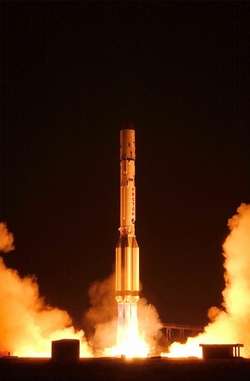Fri, Dec 12, 2008
Canadian Telecom Satellite Was Sixth Launch For 2008
 International Launch Services (ILS)
successfully carried the Ciel II satellite into space for the Ciel
Satellite Group of Canada Wednesday onboard a Russian Proton Breeze
M heavy-lift launch vehicle.
International Launch Services (ILS)
successfully carried the Ciel II satellite into space for the Ciel
Satellite Group of Canada Wednesday onboard a Russian Proton Breeze
M heavy-lift launch vehicle.
This was the sixth launch of the year, and 49th overall, for
ILS. It is the 340th launch for the Proton system since its
inception. The Proton Breeze M vehicle is built by Khrunichev Space
Center of Moscow.
The Proton vehicle lifted off from the Baikonur Cosmodrome at
7:43 pm local time (8:43 am EST). The launch vehicle carried the 5
1/2-ton satellite for 9 hours and 12 minutes, releasing it into
geosynchronous transfer orbit. Ciel II is a Spacebus 4000 model
built by Thales Alenia Space. The satellite will ultimately be
moved to 129 degrees West longitude, where it will deliver digital
television services to Canada and the contiguous United States.
"I would like to thank Ciel and SES for placing their confidence
and trust in ILS and the Proton Breeze M," said ILS president Frank
McKenna. "We entered into this launch contract in February of last
year and set the launch for December 2008; this supports ILS's
long-standing commitment to precise, on-time delivery for our
customers. Ciel II is the 16th satellite that ILS has launched for
the SES family, a successful, on-going collaboration that spans
more than a dozen years."
A US-based company, ILS holds exclusive rights to market the
Russian Proton to commercial satellite operators worldwide.
Wednesday's launch marks the third successful liftoff in a row for
the heavy booster, following the failed March 15 launch of the
AMC-14 satellite from the Baikonur.
During that mission, the Breeze M upper stage shut down two
minutes before the end of the planned second burn of its engine.
The satellite survived, and was released into a lower-than-planned
orbit. It was the third failure in as many years for the Proton M,
and the second in six months.
A Russian State Commission determined the failure was caused by
a ruptured exhaust gas conduit, which led to a shutdown of the
turbo pump feeding the Breeze M engine. The booster was cleared for
return to flight in June.
More News
Aero Linx: Model Aeronautical Association of Australia MAAA clubs are about fun flying, camaraderie and community. For over 75 years, the MAAA has been Australia’s largest fl>[...]
Touchdown Zone Lighting Two rows of transverse light bars located symmetrically about the runway centerline normally at 100 foot intervals. The basic system extends 3,000 feet alon>[...]
“Discovery and innovation are central to our mission at Virgin Galactic. We’re excited to build on our successful record of facilitating scientific experiments in subor>[...]
How To Get A Story On Aero-TV News/Feature Programming How do I submit a story idea or lead to Aero-TV? If you would like to submit a story idea or lead, please contact Jim Campbel>[...]
Student Pilot Reported That During Rotation, “All Of A Sudden The Back Of The Plane Kicked To The Right..." Analysis: The student pilot reported that during rotation, “>[...]
 ANN's Daily Aero-Linx (05.02.24)
ANN's Daily Aero-Linx (05.02.24) ANN's Daily Aero-Term (05.02.24): Touchdown Zone Lighting
ANN's Daily Aero-Term (05.02.24): Touchdown Zone Lighting Aero-News: Quote of the Day (05.02.24)
Aero-News: Quote of the Day (05.02.24) ANN FAQ: Contributing To Aero-TV
ANN FAQ: Contributing To Aero-TV NTSB Final Report: Cirrus Design Corp SR20
NTSB Final Report: Cirrus Design Corp SR20



